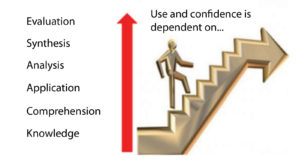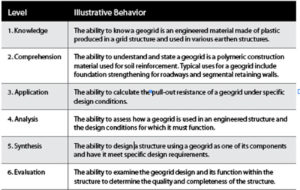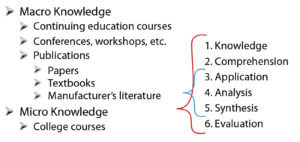
Introduction
This article is the first of a four-part series in Geosynthetics magazine on how an engineering student or practicing engineer is able to learn about geosynthetic materials. These articles are based on a panel discussion session on March 13, 2017, at the Geotechnical Frontiers conference in Orlando, Fla. Part 1 addresses the topic of how an individual learns about any technology within a college curriculum. The remaining articles will include:
- Part 2 by Shobia Bhatia, “Geosynthetic coursework at Syracuse University.”
- Part 3 by Richard Brachman, “Educate the educators.”
- Part 4 by David Suits, “Continuing education for FHWA.”
How we learn
Our ability to learn, to increase our understanding in any area, is an evolution of knowledge based on what we have learned previously. Using the subject “math” as an example, the student first learns to count, then add and subtract, divide and multiply, and so on. Once these are mastered, the student moves on to other areas of math, such as algebra, trigonometry, and calculus. Confidence within higher knowledge is based on the ability to master the fundamentals of previous knowledge. Bloom’s taxonomy (Bloom et al. 1956) defined six levels in the evolution of knowledge.

Figure 1 denotes the six levels of attainment in the development of knowledge on any subject. Table 1 shows how to apply this method to the understanding of a geosynthetic material, such as a geogrid.
Engineering education within college and continuing education
Based on previous knowledge, the student progresses through the engineering curriculum by mastering earlier coursework (Figure 2). The inability to fully master previous coursework inhibits the student’s ability to develop a sufficient understanding of new material presented in a higher level of the curriculum.
Once a student graduates from college and becomes a practicing design engineer, the ability to develop knowledge of new material typically occurs through continuing education courses, seminars, conferences, and technical session papers and presentations (Figure 3).

Although methods of education may touch on subjects within the engineering sciences courses (e.g., material science, soil mechanics, fluid mechanics), they rarely delve into the engineering sciences to the breadth and depth of the college courses (Figure 2). Without the fundamental knowledge as a foundation for new material, such as geosynthetics, the design engineer may either lack confidence in the technology or fail to fully understand the strengths or weaknesses of a specific engineered material.
Continuing education offers macro-knowledge of new technology. If geosynthetics is taught within an engineering program, the student would have the ability to develop micro-knowledge of geosynthetics by understanding, for example, soil/geosynthetic interaction under saturated and undrained conditions, and through associated coursework laboratory experiences.

The engineering education paradigm
Since 1980 the cost of a college education has increased by more than 260%. Because engineering degrees historically required more credit hours than most other college degrees, economic pressures have forced college engineering programs to reduce the number of credit hours required to obtain an engineering degree.
This compression of college courses greatly limits the ability to include new technologies within engineering programs. However, it is not impossible. The question remains, “How should geosynthetic technology be included within the engineering curriculum?” The next two articles (Part 2 and Part 3) will attempt to answer this question.
What is known is that the better the foundation of knowledge, the easier it will be to learn and apply new technologies and have more confidence in their use. Those who do not have this fundamental knowledge will have a tendency to:
- not use the technology due to lack of understanding or confidence.
- not fully understand the material’s strengths or weaknesses, thus resulting in:
–overdesign, thereby reducing its economic benefit.
–underdesign, resulting in a failure or increased yearly maintenance cost.
- increase risk with its use due to not recognizing areas of uncertainty within the design.
Finding ways to include geosynthetic technology over the entire college curriculum should be the goal of everyone within the geosynthetic community.
REFERENCE
Bloom, B. S., Engelhart, M. D., Furst, E. J., Hill, W. H., and Krathwohl, D. R. (1956). Taxonomy of educational objectives: The classification of educational goals, Handbook 1: Cognitive domain. New York , Longmans.
 TEXTILES.ORG
TEXTILES.ORG


